Kiryu
Understand
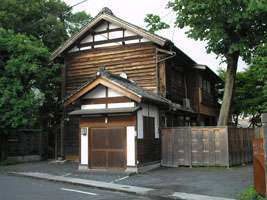
Kiryū lies about 90 km northwest of Tokyo (as the crow flies), and just across the Tochigi prefectural boundary from Ashikaga. During the Edo Era, Kiryū was known for its fine silks, an eastern match for Kyoto in western Japan. The lord of Kiryū supplied over 2,400 silk banners for the troops of Tokugawa Ieyasu in the battle of Sekigahara in 1600, and thereafter continued to pay the same tribute to the victorious Tokugawa Shogunate every year. It later became an important center for textile manufacturing during Japan's industrial revolution, and now is a manufacturing center for automotive parts and pachinko machines.
Kiryū's international sister cities are also textile and manufacturing towns: Biella, Piemonte, Italy, and Columbus, Georgia, USA. Kiryū's Columbus Street features pink and white dogwood trees and azalea bushes reminiscent of its sister city Columbus, Georgia.
The Kiryū School of Textiles, founded in 1915, has grown into Gunma University's School of Science and Technology, one of the largest in the country. Its website contains much useful information in English about the city and its history, and its many international engineering students lend Kiryū a more cosmopolitan flavor than many cities its size.
In 2005, Kiryū doubled its size by incorporating a largely rural region across the upper Watarase River valley. But the most scenic gorges and valleys of the upper Watarase fall within the bounds of Midori, a separate jurisdiction, while the headwaters and the infamous Ashio copper mine fall within the bounds of Nikko city. Nevertheless, Kiryū remains the jumping-off point for trips to Mt. Akagi and to the Watarase River valley.
Get in
By train
Kiryū lies about halfway between Oyama and Takasaki on the JR Ryōmō line, about 1 hour by local train from either end. About 30 trains per day pass through in each direction, and the fare runs about ¥1,000 each way.
The Tōbu Isesaki line limited express train Ryōmō, which requires seat reservations, stops at Tōbu Shin-Kiryu station on its run between Asakusa and Akagi. It leaves Asakusa at 40 min past the hour, costs about ¥2,400, and takes about 90 min in either direction. The short local Tōbu Kiryu line stops at Shin-Kiryū on its run between Ota City and Akagi.
The Watarase Keikoku (Valley) railway starts at JR Kiryū station and intersects the Tōbu Kiryū line at Aioi before heading up through the scenic mountains and gorges to the headwaters of the Watarase River valley. There are 18 trains a day each way between Kiryū station and Ōmama in Midori City, but only 11 that cover the full distance to Ashio and Matō, which are now administered by Nikkō. The first train leaves Kiryū at 6:36AM and the last train leaves Matō at 7:46PM. The full-distance fare is about ¥1,110 each way. For travellers already in Maebashi, the tiny Jōmō Dentetsu line runs between Chūō Maebashi and Nishi Kiryū station.
By highway bus
The Expressway Bus Salvia line runs directly between Narita airport and Kiryū 5 times each way daily for ¥4,400 (Child \2,200) one way. The trip takes about 3 hours, depending on Tokyo traffic. Five buses leave JR Kiryū station South Exit between 4:20AM and 1:20PM and five buses leave Narita for Kiryū between 8:10AM and 7:25PM.
The Airport Limousine Bus also runs directly between Haneda airport and Kiryū 4 times each way daily for ¥3,400 (Child \1,700)one way. The trip takes between 2 and 3 hours, depending on Tokyo traffic. Four buses leave JR Kiryū station South Exit at 3:00, 3:40, 5:30, and 7:50AM, and four buses leave Haneda airport for Kiryū at 4:20, 6:20, 8:20 and 10:35PM.
The overnight Sendai Liner leaves JR Kiryū station South Exit nightly at 11:30PM, arriving at Sendai station at 6AM. It leaves Sendai station nightly at 11PM, arriving in Kiryū at 5:25AM. Adult fare one-way ¥5,900 (Child \2,950); round-trip ¥10,030 (Child \5,020).
Get around
Orihime Bus
This is the public city bus system. See this link for detailed information about the various bus routes, schedules and fares.
Mayu
This is an electric free-of-charge sightseeing bus service in Kiryu. There are two routes: the Amusement Park - Yurinkan Route, and the Silk Heritage Route.
Rental bicycles
Bicycles are available for rent at the Yui Office in JR Kiryu Station. See this link for details.
Taxis
Taxis available for hire have red signs lit on the dashboard. A green lights indicate the taxi has a passenger and will not stop. The left side rear doors open automatically. When entering a taxi, please stand free of the door. Stations, etc. have taxi stands; passengers can also call a taxi by telephone. It is not necessary to tip taxi drivers, however, there is a surcharge for service between 10PM and 5AM.
City taxi companies
- Kiryu Asahi Taxi +81 277-54-2420
- Kiryu Godo Taxi +81 277-46-3939
- Numataya Taxi +81 277-44-5242
Daiko service (taxi with two drivers)
Since the laws regarding drinking and driving in Japan are extremely strict, using "daiko service" has become very popular. Under this system, a driver is provided to drive the customer's car, and the daiko taxi accompanies the customer to her/his destination where the customer's car is parked. The driver then returns with the daiko taxi.
See
Because Kiryū was largely unscathed by World War II bombing, it contains one of the highest concentrations of prewar urban architecture in Japan: wooden-sided warehouses, sawtooth-roofed textile mills, merchant storehouses, and Meiji-era adaptations of Western buildings. The old urban core of the city is easily walkable.
- 🌍 Hikobe Manor (彦部家住宅, Hikobe-ke jūtaku), 6-877 Hirosawacho (15-minute drive from the Ota/Kiryu Exit on the Kita Kanto Highway), ☎ +81 277-52-6596. weekends 10AM - 4PM (reservations required for weekday tours). Closed on weekdays (unless you have a reservation.). A fully restored Samurai residence dating back over 400 years. Hikobe direct descendants still live on the property. Declared a National Important History Site. One of the oldest private homes in the Kanto region. adults: ¥500; elementary/jr high school students: ¥300.
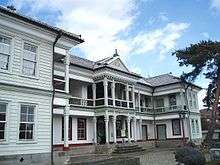
- 🌍 Kiryu Meijikan (桐生明治館), 2-414-6 Aioicho (10-minute drive from the North Exit of JR Kiryu Sta., 5-minute walk from Watarase Keikoku Railways Aioi Sta.), ☎ +81 277-52-3445. Tu-Su 9AM-5PM. Built as the Gunma Prefecture Public Health Centre in 1878, it is a classic example of pseudo-Western architecture. Inside there are exhibition rooms and a coffee/tea shop featuring a nostalgic gramophone and music of the era. Adults: ¥150; elementary and jr high school students: ¥50.
- Kiryugaoka Zoo (桐生が岡動物園), 3-8-13 Miyamotocho (15 minute walk from the North Exit of JR Kiryu Sta.), ☎ +81 277-22-4442. Over one hundred exotic animals can be seen at the zoo, including lions, giraffes, zebras, flamingoes, and penguins. Admission Free.
- Kiryu Club (桐生倶楽部), 2-9-36 Nakamachi (10 minute walk from the North Exit of JR Kiryu Sta.), ☎ +81 277-45-2755. Please inquire. A notable social gathering place built in 1919. Interior decor is reminiscent of early 20th century furnishings. Architecture is outstanding.
- Yūrinkan (有鄰館), 2-6-32 Honcho (15 minute walk from the North Exit of JR Kiryu Sta.), ☎ +81 277-46-4144. 9AM-9PM, closed: Dec 28-Jan 4. Former warehouses converted to art galleries. Includes the Kiryu Karakuri Ningyo (Mechanical Doll) Theatre. From the Meiji to the Showa Era, the Tenmangu Shrine Festival featured various theatre performances of elaborately made mechanical dolls. These masterfully made dolls are a treasure of Japanese Performing Arts history Admission Free.
- Textile Museum ‘Yukari’ (織物参考館紫), 4-2-24 Higashi (15 minute walk from the North Exit of JR Kiryu Sta.), ☎ +81 277-45-3111. 10AM - 4PM. A former sawtooth-roofed textile mill converted into a comprehensive museum of textile production over the centuries, with demonstrations ranging from silkworm cocoons to looms to dyes. adults: ¥700, university/college students:¥600, high school/jr high school students:¥500, elementary school students: ¥400.
- 🌍 Okawa Museum of Art (大川美術館, Ōkawa bijutsukan), 3-69 Kosonecho (15 minute walk from the North Exit of JR Kiryu Sta.), ☎ +81 277-46-3300. Tu-Su 10AM-5PM, closed: Dec 28-Jan 3. The Okawa Museum of Art opened in April, 1989 overlooking the city of Kiryu, a textile center. About 1,600 works of art have been collected over a period of 40 years by the museum's founder, Eiji Okawa. The museum, deceptively small on first notice, is built in stages on the hillside and provides its visitors with an amazing number of rooms to peruse its incredibly rich collection. Largest collection of works of art by Shunsuke Matsumoto and Hideo Noda in Japan. Other works of art by prominent artists from around the world. adults:¥1,000, university/high school students:¥600, jr high / elementary school students:¥300.
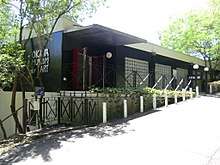 Okawa Museum of Art
Okawa Museum of Art - 🌍 Kennen Kinenkan (絹撚記念館), 1832-13 Tomoecho (5 minute walk from the South Exit of JR Kiryu Sta.), ☎ +81 277-44-2399. Tu-Su 9AM-5PM. One of the oldest buildings in Western-style architecture in the prefecture. Inside, local antiquities are displayed. adults (high school students or older):¥150, children:¥50.
- Kiryu Orimono Kinenkan (Kiryu Textile Memorial Hall) (桐生織物記念館), 6-6 Eirakucho (5-minute walk from the North Exit of JR Kiryu Sta.), ☎ +81 277-43-7272. 10AM-5PM, closed: AuG 13-16, Dec 29-Jan 3. Built for the Kiryu Textile Workers Union in the heyday of the textile industry in Kiryu, the building now serves as a place to exhibit Kiryu textiles and has a shop selling locally made textiles. Admission Free.
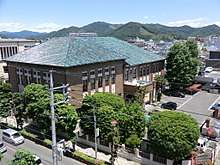 Kiryu Textile Memorial Hall
Kiryu Textile Memorial Hall - Aizawa Tadahiro Kinenkan (相沢忠洋記念館), 537 Okuzawa Niisatocho (20-minute drive from the Isesaki Exit on the Kita Kanto Highway), ☎ +81 277-74-3342. Tu-Su 10AM-5PM. Aizawa Tadahiro was the first to discover artefacts demonstrating the presence of human settlements in Japan during the paleolithic era. Many artefacts from the Iwajuku Site are on exhibit. adults (high school students or older):¥500, jr high/ elementary school students:¥250.

- 🌍 Gunma Insect World (ぐんま昆虫の森), 460-1 Tsurugaya Niisatocho (20-minute drive from the Isesaki Exit on the Kita Kanto Highway), ☎ +81 277-74-6441. Apr-Oct: 9:30AM-5PM; Nov-Mar: 9:30AM-4:30PM. Built on a traditional Japanese landscape, the museum contains a large collection of living insects, along with an array of butterflies among whom visitors can walk all year round in the heated observatory. Other buildings on the grounds offer opportunities to experience various aspects of traditional Japanese culture. adults:¥410, university/high school students:¥200, jr high school students or younger: free.
- 🌍 Kurohone History & Folkculture Museum (黒保根歴史民俗資料館, kurohone rekishi minzoku shiryōkan), 175 Mizunuma Otsu Kurohone (10-minute walk from Mizunuma Station on the Watarase Keikoku Line), ☎ +81 277-96-3125. Tu-Su 10AM-4PM, closed: Dec 28-Jan 4. Museum houses exhibits and materials related to the history of Kurohone, local lifestyle & customs. Also, visitors can also learn about the first Japanese exporters of silk yarn, Hoshino Chotaro & Arai Ryoichiro whose factories were located in Kurohone. adults:¥100, jr high /elementary school students:¥50.
- Bakery Cafe Renga (former Kanaya Lace Mfg. Corp.) (ベーカリーカフェ煉瓦:旧金谷レース工業), 1-1-55 Higaashihisakatacho, Kiryu (20-minute walk from the North Exit of JR KIryu Sta.), ☎ +81-277-32-5553. Originally Kanayoshi Textiles, the company was established by Kanaya Yoshijiro during the Meiji Era. The large sawtooth roof mill was completed in Dec 1919 and included 8 sawtooth sections. The scratch-tile, 2-storey office building was constructed during in the early Showa Era. The compound has a sawtooth roof mill, employee dormitory, family residence, warehouse, & family shrine. After closing in 2007, the mill was converted to a bakery in 2008. The north end is a multi-functional space. In 2008 it was the venue for the “Sawtooth Roof Expo.” In 2009 & 2010, with the support of JR East, the office and residence underwent restoration.
- Yanoen (Yano Store and Warehouse) (矢野園), 2-6-30 Honcho (15-minute walk from the North Exit of JR Kiryu Sta.), ☎ +81-277-45-2925. 9:30am-6:30pm. Yano Hisaemon came to Kiryu in 1717 from the Omi district of Japan. His heir established Yano Mercantile at this location in 1749. In addition to selling sake, miso & soy sauce, the shop also produced vinegar. During the Meiji Era, the shop, constructed in 1916, also sold household goods. The interior has been remodeled as a store & coffee shop.
 Yanoen-Kiryu
Yanoen-Kiryu - Jomo Railways Nishi Kiryu Station (上毛電鉄西桐生駅駅舎), 2-1-33 Miyamaecho, ☎ +81-277-22-3201. This Mansard roof station was constructed in 1928 when Jomo Railways began service. The building is a fine example of early Showa Era modern style. The interior has maintained its original ambiance.
- Yotsuji no Saika (四辻の斎嘉), 2-1-45 Higashihisakatacho (20-minute walk from the North Exit of JR Kiryu Sta.). This building was the home of the Saito family which owned and operated Saito Textile Company (CEO Saito Kahei). The buildings were constructed at the first crossroads running east from Tenmangu Shrine, the starting point of Kiryu Shin Machi. The site consists of a storehouse constructed in 1878, and a residence for which a completion ceremony took place in 1923. The buildings reflect the prosperity of the textile industry in Kiryu at the time. The site was acquired in 2012 by the current owner, Kiryu Saisei Corp. which restored the buildings and completed construction of a garage for electric vehicles, Community Bus e-Com8 "Mayu." Since 2013, the site has served as a base for Kiryu city's industrial tourism.
- Kiryu Tenmangu Shrine (桐生天満宮), 1-2-1 Tenjincho (20 minute walk from the North Exit of JR Kiryu Sta.), ☎ +81-277-22-3628. A Prefectural Cultural Treasure. Tenmangu is a classic example of Early Modern Period (mid 16th to 18th centuries) "gongen" construction designed for the enshrinement of a Shinto deity. Gables over the Inner Sanctuary and Hall of Offerings are resplendently finished in elaborate detail. Tenmangu is representative of the most highly developed architectural techniques of its era and as such has been designated a Prefecture Treasure.
 Kiryu Tenmangu Shrine
Kiryu Tenmangu Shrine - Nishinomiya Shrine (西宮神社), 2-1-1 Miyamotocho (15 minute walk from the North Exit of JR Kiryu Sta., 10 minute walk from Nishi Kiryu Sta.), ☎ +81-277-22-4390. In the year 1901, the god enshrined at Nishinomiya Shrine in Hyogo Prefecture was apportioned and brought to Kiryu. In 1905 a shrine was constructed in honor of the god. Nishinomiya is the only shrine in the entire Kanto area dedicated to the four gods Ebisu Okami, Amaterasu Okami, Susano'o no Mikoto and Okuninushi no Kami. Every year on November 19th and 20th the well-known Ebisuko Festival is held at Nishinomiya.
- Mechanical Dolls Performance (からくり人形芝居), 2-6-32 Honcho (15 minute walk from the North Exit of JR Kiryu Sta.), ☎ +81 277-46-4144. Kiryu is striving to preserve its cultural heritage by resurrecting old traditions that once served to create Kiryu's unique local color. One of these traditions is "Karakuri Ningyo" or mechanical dolls which were an integral part of Kiryu's festivals in days gone by. At present Kiryu is the only city in the whole country which has revived this great tradition, making mechanical doll performances a valuable contribution to cultural preservation. Admission Free.
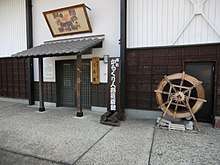 Karakuri Dolls Performance
Karakuri Dolls Performance - Honcho1, 2 chome District (本町1、2丁目地区(重伝建地区)) (15 minute walk from the North Exit of JR Kiryu Station). More than 400 years have passed since Ono Sonkichi laid out the plans for Kiryu Shin Machi and established the long avenue which has become the commercial center of Kiryu, Honcho Street. The first two districts, 1 and 2 chome, have many buildings whose classical architecture reveal the nostalgic past. A stroll along Honcho Street, beginning at Tenmangu Shrine will give you a wonderful idea of the textile history which still dominates Kiryu's character and ambiance. If you turn off Honcho onto one of the alleyways leading east or west, you are bound to encounter some of the many still remaining sawtoothed roof factories chracteristic of textile mills.
- Gunma University Memorial Hall (群馬大学工学部同窓記念会館), 1-5-1 Tenjincho (15 minute walk from the North Exit of JR Kiryu Station). Registered tangible cultural properties. Founded on March 15, 1916 as the Kiryu School of Weaving and Dyeing Technology, in the following year it became the Kiryu Technical High School. After many years, in 1944, the name was changed again to the Kiryu School of Technology. Finally, in 1949, it became the Faculty of Engineering of Gunma University and has continued in this capacity to the present. At the time the school was first established, local technical specialists were called upon to form the faculty. Since that time, however, its scope has expanded greatly. There are now many foreign students who contribute to the international atmosphere of this institution of higher learning. Memorial Hall has received much attention as an excellent example of modernism combined with classicism which was so typical of the Taisho Period in which it was built. This building is now used for lectures, exhibitions, and on occasion, concerts. It has been declared a prefectural cultural asset and is loved by Kiryu natives for its nostalgic ambiance.
- Kiryu Performing Arts Center (桐生市市民文化会館), 2-5 Orihimecho (10 minute walk from the South Exit of JR Kiryu Station), ☎ +81 277-40-1500. 9:00 am to 10:00 pm. The Kiryu City Performing Arts Center is located on a 28,000 sq. m. tract of land with an adjacent parking area for 550 automobiles. The building itself is approximately 18,000 sq. m. in area, with 4 floors rising to 30.62 m. above ground and with one level below ground. The basement is constructed of reinforced concrete while other parts are of steel frame construction. The roof of the structure resembles the shape of a cocoon, recalling Kiryu's long history of silk manufacturing. Closed on Tuesday.
- Seki no Magaibutsu (関の磨崖仏), Seki 67-1 Niisatocho (10 minute drive to north from Niisato Station of Jomo Dentetsu Railways). Designated a Prefectural Important Cultural Asset on November 15, 1972. There are three engravings on a boulder near the foot of the Fudo Bridge over Kaburaki River in the Seki district. This boulder was formed by the accumulation of ash from lava flows from eruptions on Mt. Akagi. The boulder is 128 cm in height, 60 cm in width and 80 cm in depth. The Amida Buddha in the center stands for eternal life; the Kannon Bodhisattva on the right stands for the spirit of salvation; and the Seshi Bodhisattva on the left stands for the spirit of asceticism. These carvings are believed to date from the Kamakura Era. The rock has been designated an Important Cultural Asset by the prefecture.
- Suidoyama Memorial Hall (水道山記念館), 1-5-7 Tsutsumicho (20 minute walk from the North Exit of JR Kiryu Station), ☎ +81 277-44-5257. 9:00 am to 5:00 pm. The Suidoyama Kinenkan (Memorial Hall) was constructed in 1932 as the Kiryu Water Supply Office. The office reported to the Motojuku Purification Plant regarding standing water volume and level, contributing to the smooth operation of the water purification plant. During the 6th Expansion Project for upgrading electrical and water meter equipment, conducted between March and November, 1972, an electromagnetic curent meter was installed. Because of this installation, the Suidoyama Water Supply Office was closed, concluding 40 years of service. Since that time, Kiryu City has continued to grow and prosper. The Water Supply Office underwent renovation during 1985 and 1986 and upon completion, was renamed the Suidoyama Kinenkan (Suido Mountain Memorial Hall). The Kinenkan is now used to welcome visitors to the city and to receive important guests. Its rooms are available for exhibitions and meetings. Closed on Monday, Tuesday, Dec. 29 to Jan. 3. Admission free.
Do

- Kiryu Yagibushi Festival (桐生八木節まつり), streets in downtown Kiryu. first Friday, Saturday and Sunday in August. The festival is the largest event of the year in Kiryu. During the 3-day long event, more than 500,000 people from Gunma Prefecture and other parts of Japan visit the city. The major focus is Yagibushi folk dancing which takes place at various locations on the streets of downtown Kiryu. Traditional musicians sit on bandstands, around which festival-goers dance through the evening. The traditionally decorated streets are lined with stalls featuring various traditional festival foods and games, souvenirs, etc.
- Ebisuko (festival) (桐生ゑびす講, kiryū ebisuko), downtown Kiryu and Nishinomiya Shrine (10-minute walk from the North Exit of JR Kiryu Station). annually, November 19th and 20th. An autumn festival focusing on the sale of "kumada" and "otakara" or good luck charms for merchants. Streets and the area around the shrine are lined with stalls selling these talismans along with festival food and souvenirs. It bustles with people and the sound of shopkeepers hawking their wares.
- Kiryu Fashion Week (桐生ファッションウィーク), downtown Kiryu (A short walk from Kiryu Station / Nishi Kiryu Station to various sites). beginning of November. Various events are held at locations throughout the city during a one-week period. Events include fashion shows, textiles, art, & local history and culture. The Classic Car Festival, held since 2006, brings together distinctive automobiles from Japan and overseas. Held on the campus of Gunma University School of Science & Technology.
- Kiryugaoka Amusement Park (桐生が岡遊園地, kiryū-ga-oka yūenchi), 4-1-1 Miyamotocho (15-minute walk from the North Exit of JR Kiryu Station), ☎ +81 277-22-7580. Mar-Oct: 9:30AM-5PM; Nov-Feb: 9AM-4PM. Located next to Kiryugaoka Zoo. Attractions in the amusement park are geared toward younger children. Famous site for viewing cherry blossoms in spring. Free admission; separates fees for rides.
 Kiryugaoka Amusement Park
Kiryugaoka Amusement Park - Tenmangu Antiques Flea Market (天満宮古民具骨董市, tenmangū komingu kottōichi), Tenjincho 1chome (located on the grounds of Tenmangu Shrine. A 20-minute walk from the North Exit of JR Kiryu Station, in front of Gunma Univ. Kiryu Campus). 1st Saturday of the month (special dates set for January, August & November). Antique dealers from all over the Kanto area converge on this site. Everything from kimonos to antique ceramics and furniture is on sale.
- Kaiba Sayaichi Market (買場紗綾市), Honcho 1 chome (15-minute walk from the North Exit of JR Kiryu Station). 1st Saturday of the month. Open air market selling textiles and miscellaneous goods & handicrafts. During the Edo Era, a type of silk called “saya” became popular. As a result, the silk market that was established on the compound of Tenmangu Shrine was named the “Saya-ichi” or Saya market. Later, in 1883, a shopping street was established for the sale of local products and became known as “kaiba” or “shopping place, ” or the “uptown market,” as opposed to the “downtown market” which was situated near the present day Don Quijote Department Store. These shopping areas sold textiles and goods used in daily life.
- Kiryu Rakuichi Market (桐生楽市), Honcho 3 chome (10-minute walk from the North Exit of JR Kiryu Station). Open air market for discounted goods and handicrafts
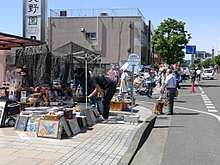 Kiryu Rakuichi Market
Kiryu Rakuichi Market - Niisato Festival (新里まつり, niisato matsuri) (Held in sites around the Niisato area). Annually, August 15. Yagibushi dancing and a firework display are the main attractions of this summer festival.
- Kurohone Summer Festival (くろほね夏まつり), Kurohone Sports Park (A short walk from Mizunuma Station on the Watarase Keikoku Line). Annually, August 15 & 16. Catching trout by hand, Yagibushi dancing, & fireworks are the main attractions.
- 🌍 Kiryu Nature Sanctuary (桐生自然観察の森, Kiryū shizen kansatsu no mori), 2-902-1 Kawauchi-chō (10 minute drive from the North Exit of JR Kiryu Sta.), ☎ +81 277-65-6901. Mar-Oct: 9AM-4:30PM; Nov-Dec: 9:30AM-4PM. Situated in a woodland area at the foot of the mountains on the west side of Kiryu, the Nature Centre has exhibits and a lecture room. The park features many nature trails, an observation building for bird-watching. A large variety of plants and animals can be viewed throughout the seasons. Admission Free.
- 🌍 Caribbean Beach (カリビアンビーチ, karabian bīchi), 461 No Niisatocho (15-minute drive from the Isesaski Exit on the Kita Kanto Highway), ☎ +81 277-70-2121. F-W 10AM- 9PM (last entry at 8PM). One of the largest all-season indoor water parks in the Kanto region. Facilities include a wave pool, a current pool, water slides, jacuzzi and an olympic size swimming pool. Admission: Varies by season.
- Watarase Keikoku Railway Line (わたらせ渓谷線, watarase-keikoku-sen). Buy a one-day pass on the Keikoku Railway that runs up the Watarase River valley, get off at one of the larger stops, hike around a bit, and hop back on the next train. Trains run at less than hourly intervals, so check the schedule at each station before setting out. Stop off at Mizunuma Station to enjoy the refreshing public baths at the only "in-Station" spa in all of Japan! In Autumn, many photographers visit along this railway to take beautiful scenery with colorful autumn leaves.
- Daruma Fair at Fumonji Temple (だるま市, daruma-ichi ; 普門寺, fumon-ji), 4-2274 Hishimachi (About a 20-minute drive from Tobu Shin Kiryu Sta. About 10 minute drive from the North Exit of JR Kiryu Sta.), ☎ +81 277-43-5683. The annual Daruma Fair will take place on the third Sunday of January at Fumonji Temple. Parking lots available. This fair was first started in Kiryu in1964. The “Daruma” figure is said to bring good fortune, commercial success, household safety and protection from dangers and is sold at the many stalls along the streets in the vicinity of and entrance to the temple.
- Mikagari Ceremony at Kamojinja Shrine (御篝神事, mikagari shinji), 6-833 Hirosawacho (About a 15-minute drive from Tobu Shin Kiryu Station. About a 20-minute drive from the South Exit of JR Kiryu Sta.), ☎ +81 277-54-5492. The Mikagari Ceremony is held every year on February 3 at Kamo Shrine in Hirosawacho. The ceremony dates back to the Edo Period, during the 19th century. This ceremony is said to serve to protect the participants from evil during the coming year. Young men, dressed in white, undergo a purification rite, after which they throw beans, a custom carried out all over Japan as away to ward off evil spirits and welcome in the spring season.
- Azuma Park (吾妻公園), 3-10-1 Miyamotocho (About a 5-minute drive from the North Exit of JR Kiryu Sta. About a 20-minute walk from the North Exit of JR Kiryu Sta.), ☎ +81 277-22-8636. 10AM-5:30PM. Azuma Park is a serene escape from the busy outside world. Very quiet area. As the seasons come and go, the park takes on different aspects, offering a multitude of flowers and trees for visitors’ enjoyment. Parking lots available. Main flowering plants (tulips: about 12,000 bulbs, irises: about 350 rhizomes, cherry trees: about 500, Azaleas: about 5,000 bushes). There is a tea house in the park. You are able to enjoy tea ceremony there on the third Sunday of every month (fee: 500 yen). Admission Free.
- Kiryu Minami Park (桐生市南公園, kiryū-shi minami-kōen), 5-4716-11 Hirosawacho (About a 15-minute drive from the South Exit of JR Kiryu Sta. About a 10-minute drive from Tobu Shin Kiryu Sta.), ☎ +81 277-52-3456, e-mail: minami-k@kiryu-piif.jp. Plum grove, lawn open space, play field, tennis court, baseball field, jogging course. Enough parking space. Admission Free.
- Fishing spots. Umeda Lake (Kiryu River Dam: rainbow trout, bass, lake smelt). Kiryu River (iwana trout, yamame trout). Watarase River (ayu trout, iwana trout). Kurohone River ravine fishing (bait/fly fishing) Iwana trout, Rainbow trout, etc.)
- Higiri Jizoson Festival at Kan'nonin Temple (観音院日限地蔵尊縁日), 2-13-18 Higashi (About a 5-minute drive from the North Exit of JR Kiryu Sta. About a 15-minute walk from the North Exit of JR Kiryu Sta. About a 10-minute drive from Tobu Shin Kiryu Sta.), ☎ +81 277-45-0066. On the 24th of every month, there is a temple festival called Ennichi. Main street is closed to cars for this monthly temple festival, and there are many street stalls. This temple festival is very lively. Not only people from Kiryu but also people from Saitama and Tokyo visit this event every month. Even the normal day, smoke of the incense stick by the visitors does not cease. The devotion is done every day, and joins many people’s faith. Parking lots available.
 Higirijizoson Fair-Kan'non In Temple
Higirijizoson Fair-Kan'non In Temple - Seven Herbs Porridge Gathering (Nanakusa Gayu) at Sozenji Temple (七草粥、崇禅寺), 2-651 Kawauchicho (10-minute drive from Tobu Aioi Station or JR Kiryu Station.), ☎ +81 277-65-9422. 6AM-8AM. On the 7th day of the New Year, it is a Japanese custom to eat a gruel made of rice with seven herbs as a protection for good health in the year to come. The seven herbs are: seri or water dropwort; nazuna or shepherd's purse; gogyo or cudweed; hakobera or chickweed; hotokenoza or nipplewort; suzuna or turnip; and suzushiro or daikon. You also can enjoy beautiful trees and flowers during a year.
- Public Tea Ceremony (茶道体験:吾妻公園茶室「悠緑庵」), Miyamotocho 3 chome, Kiryu ("Yuryokuan" tea house in Azuma Park, 15-minute walk from Nishi Kiryu Station, 20-minute walk from the North Exit of JR Kiryu Sta.). 10AM-3PM. The Kiryu Tea Ceremony Association conducts tea ceremonies "Tsukigama" on the third Sunday of every month. Everyone is welcome to participate. No prior reservations are required. 500 yen.
- Kobo Kazahana (handmade textile workshop) (工房風花), 1-1-55 Higashihisakatacho (20 minute walk from the North Exit of JR Kiryu Station), ☎ +81 277-32-6387. 10:00-17:00. Located in the Bakery Cafe RENGA. You can make your own original silk stall by using hand weaving machine. Closed on Tuesday.
- Kiryu Youth Outdoor Activities Center (桐生市青少年野外活動センター), 5-7423 Umedacho (20 minute drive from the North Exit of JR Kiryu Station), ☎ +81 277-32-2644. The Kiryu Youth Outdoor Activities Center was constructed by Gunma Prefecture. It is located deep in the mountains in Umeda, the northernmost district of Kiryu. The facility includes indoor overnight accommodations for 130 persons, outdoor camping facilities for 100 persons, classrooms, a gymnasium/play hall, a cafeteria, and campfire facilities. Reservations can be made for groups of 3 and over and families. The center is closed on Mondays and during the New Year holidays.
Sports
Public swimming pools
- Kiryu Swimming Pool (市民プール)at Kiryu Sports Park (3-300 Aioicho), phone:+81 277-53-8830, in front of Kiryu Kyujomae Station of Jomo Dentetsu Line. Operating period: July 8, 2017-August 27, 2017, 10AM-5PM, Entrance: Adults: ¥380, High school: ¥140, Jr HS and below: ¥70.
- Rooftop Swimming Pool (屋上運動公園プール)at Sakaino Water Treatment Facility (Sakainocho), phone:+81 277-44-6184, about 10 minutes' drive from JR Kiryu Station. Operating period: July 8, 2017-Aug 31, 2017. 9:30AM-4PM, admission free. This pool is for the use of preschoolers and elementary school age.
- Caribbean Beach (カリビアンビーチ、indoor swimming pool) ,(461 no, Niisatocho) phone:+81 277-70-2121. One of the largest all-season indoor water parks in the Kanto region. Facilities include a wave pool, a current pool, water slides, jacuzzi and an olympic size swimming pool.
Ice skating
- Kiryu Skate Center (桐生スケートセンター、Ice Skating) (7-3-50 Higashi), phone:+81 277-44-9317, 5 minutes' drive from JR Kiryu Station. The Kiryu Skate Center is the only indoor ice skating rink in the Tomo area. Figure skates and ice hockey skates are available for rent. The center also sponsors ice skating workshops. Admission (all day): ¥990 (high school students and over), ¥480 yen (jr. high school students and below). Skate Rental (all day): ¥380 yen (high school students and over) ¥170 yen (jr. high school students and below). Closed on Tu W, unless these days fall on a holiday and winter and spring break at Elementary and Jr. High School in which case the rink will be open for holiday skating. Also, closed Dec 31 & Jan 1.
Bowling
- Kiryu Star Lanes (桐生スターレーン)(2-1821-36 Tomoecho), phone:+81 277-44-8155. 5-minute walk from the South Exit of JR Kiryu Sta.
Hiking trails
- Mt. Nemoto Hiking Trails - Long ago Mt. Nemoto was a popular site for pilgrimages to Nemoto Shrine. The Naka Ridge Course follows along the top of the mountain ridge, offering panoramic views of the forested valleys below. The surrounding forest is listed in the "Top 100 Forests in Japan." The hiking courses are for advanced level hikers. For a map and details, please see here.
- Narukami / Azuma Mountain Trails - The trails lead up to Mt. Narukami and from there over to Mt. Azuma. The course is for intermediate - advanced level hikers. Along the way, the trail merges with the Shutoken Nature Trail and can eventually hike to the Kiryu Nature Sanctuary in Kawauchi. From the peak of Mt. Azuma there is a panoramic view of the Kanto Plain as it stretches south toward Tokyo. For a hiking map, see here.
- Shutoken Nature Trail - This trail begins at Kiryu Station and leads through Azuma Park to the summit of Mt. Azuma. The course is suitable for intermediate or advanced level hikers. Hikers can choose to proceed north to Mt. Narukami or go west to the Nature Sanctuary where many species of birds, plants and insects can be observed.
- Hishakuyama Castle Ruins Hiking Trails - The ruins of Kiryu Castle, constructed in 1350 AD, are located on the peak of this mountain. The trail leads up through the forest. Along the way, hundreds of cherry trees have been planted, making this trail a beautiful climb in springtime. The trail is suitable for beginner level hikers. For a map and further details, see here.
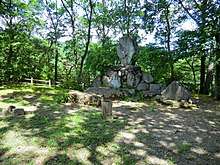 Hishakuyama Castle Ruins
Hishakuyama Castle Ruins - Hishi Kannonyama Hiking Trails - The trails here lead past Senryuin Temple and ovevr Kannon-yama and Shimobishi-yama, and then down to Fumonji Temple or Bunshoji Temple. The trails are neither too steep nor strenuous, making them an excellent choice for beginner level hikers. There is a panoramic view of Kiryu City from Gachin-yama. For a detailed hiking map, see here.
- Hishi Isshiki Hiking Trails - From the entrance at Sakashimo-yama, past Kibune Shrine, the trail leads over Isshiki Raiden-yama to an Observation Deck. Along the way, hikers can see a field of dogtooth violets blooming in spring and a firefly zone popular in early summer. The course is approximately 2.5 km in length and is suitable for beginner level hikers. For a detailed trail map, see here.
- Chausuyama Hiking Trails - From the peak of Chausu-yama, hikers have a 360 degree panoramic view of the city of Kiryu and south over the Kanto Plain to Tokyo. This course is suitable for beginner level hikers. Course is known for its plum trees in springtime. The trail is approximately 5 km in length. For a detailed trail map, see here.
- Hikobe Manor / Kamo Shrine Hiking Trails - This hiking area is known for two historically important sites: Hikobe Manor and Kamo Shrine. The trails are ideal for beginner level hikers. Approximately 6 km in length. For a detailed trail map, see here.
Camping
- Hanamigahara Forest Park (花見ヶ原森林公園)- Located at the foot of Mt. Akagi in the Kurohone district of Kiryu, the park is at an elevation of 1200 m. The park features campsites and barbecue facilities. There are many azaleas planted in the park, making springtime strolls through the park very pleasant. Hiking trails to Mt. Akagi start from this park. Phone (in Japanese only) +81 277-96-3131. Parking for 200 vehicles available.
- Riheijaya Forest Park (利平茶屋森林公園)- One of the trails for hiking to Mt. Akagi departs from this park. There are bungalows and campsites located along a stream running through the park. Barbecue facilities are also available. The park is in the Kurohone district of Kiryu. Phone (in Japanese only,) +81 277-96 2588. Parking for 80 vehicles available.
Buy
- Tourism & Products Shop "Watarase" (観光物産館わたらせ), 11-1 Suehirocho (Located inside Kiryu Station at the South Entrance), ☎ +81 277-40-1888. 9AM-6PM. Open year round. Items: textile products, Kinopi goods, foods (Udon, Snacks, Sweets etc.), etc.
- Kiryu Orimono Kinenkan (桐生織物記念館), 6-6 Eirakucho (5-minute walk from the North Exit of JR Kiryu Sta.), ☎ +81 277-43-7272. Tu-Su 10AM-5PM. Closed the last Saturday and Sunday of the month. Items: textile products made in Kiryu (bag, necktie, obi, kimono, wallets, silk fabric, sell-phone charms, wall ornament, etc)
- Kiryu Local Industries Promotion Centre (桐生地域地場産業振興センター), 2-5 Orihimecho (10 minute walk from the South Exit of JR Kiryu Sta.), ☎ +81 277-46-1011. Tu-Su 9AM-6PM. Closed during the New Year holiday. Items: textile products, Kinopi goods, foods (Udon, Sake, Shiitake Mashroom, Snacks, Sweets etc), etc.
- Umeda Furusato Centre (梅田ふるさとセンター), 5-7568-1 Umedacho (20 minute drive from the North Exit of JR Kiryu Sta.), ☎ +81 277-32-1100. Tu-Su 9AM-5PM. Closed during the New Year holiday. Items: foods, small items
- Michi no Eki Kurohone Yamabiko (道の駅くろほね・やまびこ), 91-4 Shimotazawa Kurohone, ☎ +81 277-96-2575. 9AM-5PM. Closed during the New Year holiday. Items: foods
- Niisato Farmers Market (新里町農産物等直売所), 553-1 Akagiyama Niisatocho, ☎ +81 277-74-4100. Mar-Oct: 9AM-5PM; Nov-Feb: 9AM-4PM. Items: foods
- Textile Museum Yukari (織物参考館紫), 4-2-24 Higashi (15 minute walk from the North Exit of JR Kiryu Sta.), ☎ +81 277-45-3111. Tu-Su 10AM-4PM. Also open when Monday is a national holiday. Items: textile calendar and other textile products.
- Yukatayasan (Japanese "kimono" "yukata" shop) (ゆかたやさん), 9-14 Suehirocho (5 minute walk from JR Kiryu Station), ☎ +81 277-30-3016. Th-Tu 1PM-7PM. Yukata (summer kimono) and related goods.
- Kiryu Washi Workshop (桐生和紙工房), 5-7348 Umedacho (20 minute drive from the North Exit of JR Kiryu Sta.), ☎ +81 277-32-0201. Handmade washi papers (various size and purposes of papers). Residence of Hoshino family.
- Shopping for Local Specialties of Kiryu.
Eat
Kiryu is famous for its udon (thick noodles made with wheat flour). There are many forms of udon from extremely wide, flat noodles known as "himokawa noodles" to rather thin flat noodles vaguely reminiscent of fettuccine in shape. Udon is eaten hot or cold. There are many udon shops around the city of Kiryu, ranging in price from very cheap to gourmet-range. In addition to udon noodles, Kiryu is also the home of "sauce katsudon" - a fried pork cutlet seasoned with a secret sauce and served on a bed of hot rice. There are several restaurants serving this tasty dish, while Shitamiya is generally recognised as the originator. No trip to Kiryu would be complete without sampling udon and sauce katsudon.
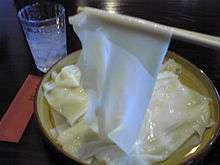
- Himokawa Udon Noodles Furukawa Udon Shop -Park Inn Kiryu (ひもかわうどん:ふる川), 2-2-3 Tomoecho (1st floor of Park Inn Kiryu, 1 minute from the South Exit of JR Kiryu Sta.), ☎ +81 277-46-4146. Furukawa is considered the home of the extremely wide (over 15 cm) himokawa udon noodles. Gunma Prefecture is a producer of wheat, and there is a long tradition of eating wheat noodles. Some say the extra-wide noodles are reminiscent of the kimono obi produced in Kiryu over the years. Furukawa Aioi Branch is located in 2-735-15 Aioicho. 5 minute walk from Aioi station of Tobu Line and Watarase Keikoku Railway.
- Sauce Katsudon Shitamiya Honten (ソースかつどん:志多美屋本店), 1-1-1 Hamamatsucho (15 minute walk from the South Exit of JR Kiryu Sta.), ☎ +81 277-44-4693. F-W 11AM-2PM; 5PM-8PM. Closed 3rd Friday of each month. Sauce Katsudon is by far Kiryu's most famous dish. While the name "souce katsudon" is used elsewhere, the popular flavor loved by locals is unique to Kiryu. There are rastaurants in Kiryu specializing in this local favorite.
- Kororin Shumai (コロリンしゅうまい), 5-204-23 Aioicho (5 minute drive from Tobu Aioi Station or Watarase Keikoku Railways Aioi Station.), ☎ +81 277-53-8617. 10AM-7PM. The steamed dumpling-like shumai are then seasoned with a Worchestershire-like flavored sauce and topped off with some nori (dried seaweed) flakes. Closed on Mondays.
- Yaki Manju (焼まんじゅう)Known all over Japan, these wheat cakes roasted over charcoal and basted with sweet soy sauce are delicious anytime of day. Gunma Prefecture is a wheat growing region, making wheat-based noodles and buns a homegrown favourite. Best eaten at fairs and festivals, yaki manju are also available at local gift and souvenir shops.
- Yakisoba with Potatoes (ポテトやきそば)Yakisoba is eaten all over Japan, but Kiryu's hometown version is noodles fried with worchestershire sauce, with potatoes, dried seaweed and fried eggs. Delicious!
- Hanapan (花ぱん)These soft, sweet cookie-like treats have a history of over 100 years in Kiryu. Each shop produces its own variation in terms of shape and size. Perfect accompaniment to tea! These treats are available at local confectionary stores and at gift and souvenir shops in Kiryu.
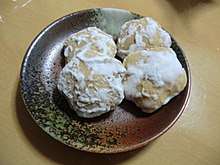 Kiryu Hanapan Cookies
Kiryu Hanapan Cookies - Ice Manju (アイスまんじゅう)For those fond of frozen treats, these red bean filled milk icicles are a delicious summer refreshment. Available in local convenience stores, supermarkets and some confectionary stores.
- Bisuroll (ビスロール)These butter rolls are a hybrid croissant-biscuit cross. They are a perfect accompaniment to morning coffee or afternoon tea. Slightly sweet, they are delicious with jam. Available at local bakeries.
- Trattoria Kitchen Makaroni (キッチンマカロニ), 2-14-30 Nishikicho (20-minute walk from the North Exit of JR Kiryu Sta.), ☎ +81-277-46-9325. Pasta, pizza, sweet and others, closed on Sunday
- Kyara (伽羅), 6-11 Eirakucho (5-minute walk from the North Exit of JR Kiryu Sta.), ☎ +81-277-22-9425. 11:30 am-7 pm. omelette with rice, pasta, curry rice and others
- Pizzeria Antimo (ピッツェリア アンティモ), 3-4-30 Honcho (15 miinute walk from the North Exit of JR Kiryu Sta.), ☎ +81 277-32-3658. 11 am-2:30 pm, 5 pm-10 pm. pizza, pasta
- Restaurant Chocolat Noix (ショコラ・ノア), 1-1117-1 Tomoecho (5 minute walk from the South Exit of JR Kiryu Station), ☎ +81 277-44-5553. French restaurant, lunch from 11:30 am, dinner from 6:00 pm, closed on Monday
- Umeda Furusato Center (梅田ふるさとセンター), 5-7568-1 Umedacho (north of Kiryu River Dam) (20 minute drive from the North Exit of JR Kiryu Station), ☎ +81 277-32-1100. The Umeda Furusato Center sells many locally produced items. In particular, it is well known for its handmade soba and udon noodles. The noodles are served in the small dining area, where guests can relax and enjoy the beautiful natural surroundings. In addition to the dining room, there is a shop where locally produced items, including cucumbers, eggplant, tomatoes, fresh shiitake mushrooms, wild mountain vegetables and other harvested-that-morning produce are sold. Next to the shop there is an exhibition room where local artisans and artists sometimes exhibit their works. Closed on Monday.
- Kuri Manju (Fujikakeya) (栗まんじゅう:藤掛屋), 2-5-2 Nishikicho (15 minute walk from the South Exit of JR Kiryu Station), ☎ +81 277-45-0630. These chestnut-shaped manju (cake buns) are filled with red bean paste. These extremely popular manju are available at the Fujikakeya Kuri Manju shop in Nishikicho, Kiryu. Closed on Tuesday.
- Thai Thai (タイタイ:タイ料理レストラン), 2-1821 Tomoecho (5 minute walk from the South Exit of JR Kiryu Station, Behind Kiryu Main Post Office), ☎ +81 277-47-1233. 11:30am-2:30pm, 6pm-9:30pm. Thai cuisine restaurant. Closed on Wednesday.
- BUDDHA Indian cuisine (ブッダ:インド料理), 8-24 Suehirocho (5 minute walk from the North Exit of JR Kiryu Station), ☎ +81 277-32-3821. 11pm-3pm, 5pm-10pm. Closed on the second Wednesday and last Wednesday of every month.
- Sauce Katsudon Fujiya Shokudo (藤屋食堂), 5-49 Kiyosecho (15 minute walk from the South Exit of JR Kiryu Station (near Kiryu Commercial High School)), ☎ +81 277-45-1805. 11 pm-2:30 pm, 5 pm-8:15 pm. Sauce Katsudon is one of the Kiryu's specializing cuisine. Closed on Monday and 2nd Tuesday.
Drink
- Uotami (tavern, 魚民 'fish nation'), Hon-cho 5-52, Takeuchi Bldg 1-2F (on the east side of Hon-cho-dori, half a block from Suehiro-dori, which runs past the north exit of JR Kiryu station), ☎ +81 277-47-0388. daily 5PM-10PM. A large Japanese-style izakaya with a wide range of seafood and other snacks to go with an equally wide range of drinks, including regional sakes. Extensive picture menus for both food and drink, but not much English. Small bottles of sake run about ¥500 to ¥800, snacks start from about ¥250, with many choices in the range of ¥350–650.
- Izakaya Don (tavern, 居酒屋どん), 5-67 Honcho (10-minute walk from the North Exit of JR Kiryu Sta), ☎ +81-277-22-8855.
- Donsantei (tavern, 海鮮居酒屋どんさん亭), 2-5-7 Shinshuku (5-minute drive from the South Exit of JR Kiryu Sta.), ☎ +81-277-46-5222.
- Takeno (tavern, たけの), 5-38 Honcho (10-minute walk from JR Kiryu Sta.), ☎ +81-277-44-5301.
- Sennen no Utage (tavern, 千年の宴), 2-9-38 Miyamaecho (near the North Exit of JR Kiryu Sta.), ☎ +81 277-47-0488.
- Toyomaru Suisan (tavern, 豊丸水産) (near the North Exit of JR Kiryu Sta.), ☎ +81 277-20-7003, toll-free: 0120-70-7621 (domestic).
- Kaisen Dining Bikinikan (海鮮ダイニング美喜仁館), 19-1 Motojukucho (5-minute walk from the South Exit of JR Kiryu Sta.), ☎ +81 277-46-3458. 11 am-11 pm.
- Iroha honpo (tavern, いろは本舗), 2-1893-10 Tomoecho (near the South Exit of JR Kiryu Sta.), ☎ +81 277-44-7525. 4 pm-.
- Shoya (庄や), 5-16 Suehirocho (near the North Exit of JR Kiryu Sta.), ☎ +81-277-46-1351. 17:00 -.
Sleep
- Toyoko Inn Kiryu-eki Minami-guchi (東横イン桐生駅南口), 2-1810-18 Tomoecho (1 minute walk from the South Exit of JR Kiryu Station), ☎ +81 277-44-1045.
- Park Inn Kiryu (パークイン桐生), 2-2-3 Tomoecho (1 minute walk from the South Exit of JR Kiryu Station), ☎ +81 277-22-8910.
- Toseikan (桐盛館), 7-17 Suehirocho (3 minute walk from the North Exit of JR Kiryu Station), ☎ +81 277-22-5421.
- Silver Hotel (シルバーホテル), 4-13 Suehirocho (3 minute walk from the North Exit of JR Kiryu Sta.), ☎ +81 277-22-7717.
- Kiryu Grand Hotel (桐生グランドホテル), 5-111-3 Aioicho (20 minute drive from the Ota-Yabutsuka Exit on the Kita Kanto Highway, 15 minute drive from JR Kiryu Sta., 5 minute walk from Tobu Aioi Sta.), ☎ +81 277-53-6211.
- Pearl Hotel (パールホテル), 2-9 Suehirocho (5 minute walk from the North Exit of JR Kiryu Station), ☎ +81-277-22-0166.
- Business Hotel Nishi Kiryu (ビジネスホテル西桐生), 4-14 Eirakucho (8 minute walk from the North Exit of JR Kiryu Station), ☎ +81 277-22-2985.
- Ace Hotel (エースホテル), 2-1893-9 Tomoecho (near the South Exit of JR Kiryu Sta.), ☎ +81 277-47-4910.
- Seifuen (清風園), 5-7652 Umedacho (25 minute drive from Kiryu Station. 1 hour drive from the Ota-Yabutsuka Exit on the Kita Kanto Highway), ☎ +81 277-32-1181.
- Hotel City (ホテルシティー), 2-2955-2 Hirosawacho (5 minute walk from Tobu Shin Kiryu Station), ☎ +81 277-54-1927.
- Nashigi Hot Springs Nashigikan (梨木温泉梨木館), 285 Shukumeguri Kurohonecho, ☎ +81 277-96-2521.
Go next
| Routes through Kiryu |
| Akagi ← | N |
→ Ota → into |
| Maebashi ← Isesaki ← | W |
→ Ota → Ashikaga → Sano |
| Nikko ← Midori ← | N |
→ Ota → Tatebayashi → Iwatsuki |
| Nakanojo ← Shibukawa ← Maebashi ← | N |
→ END |